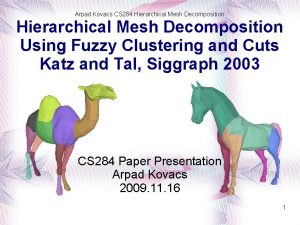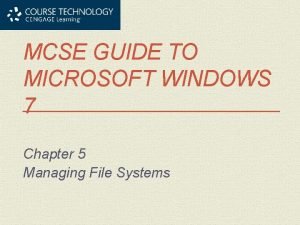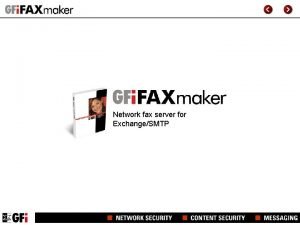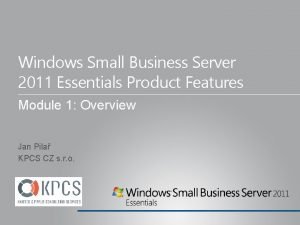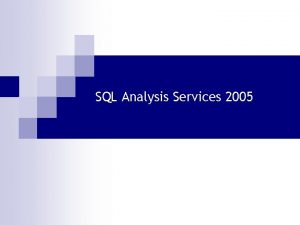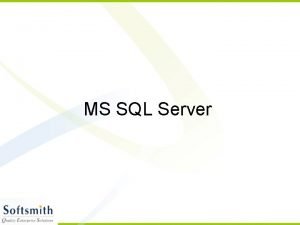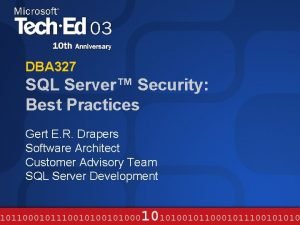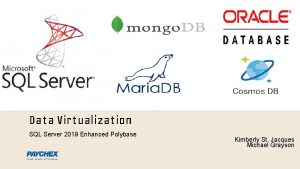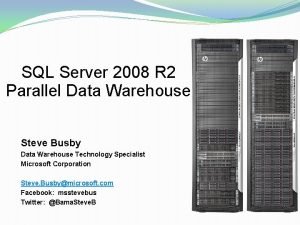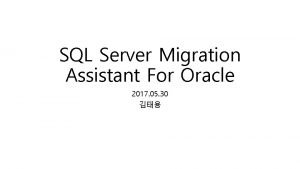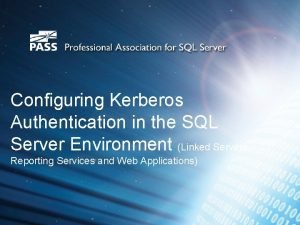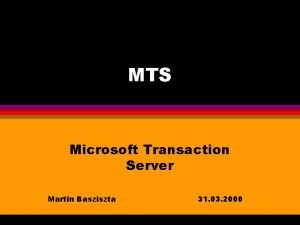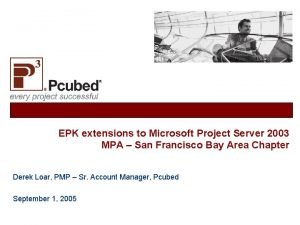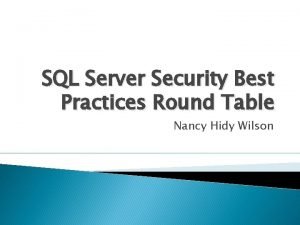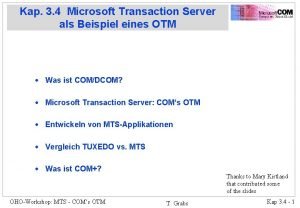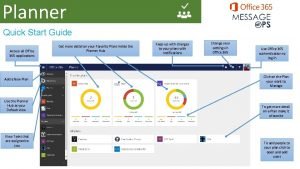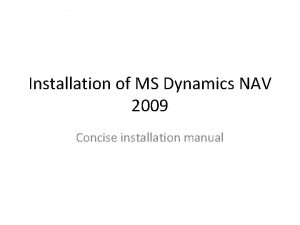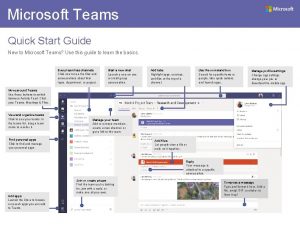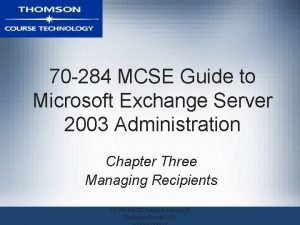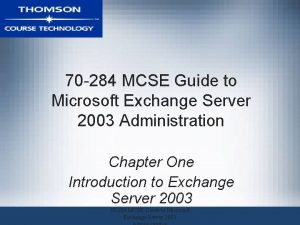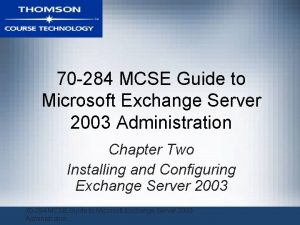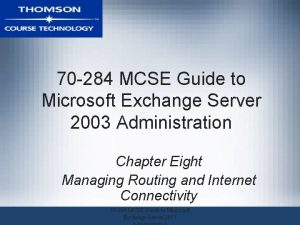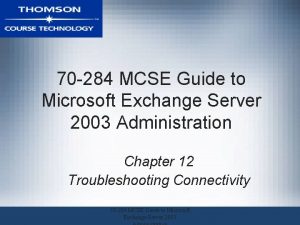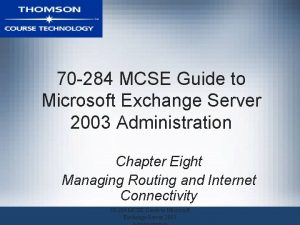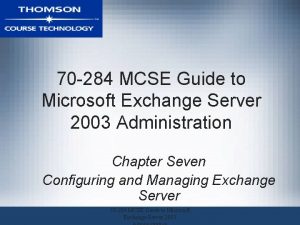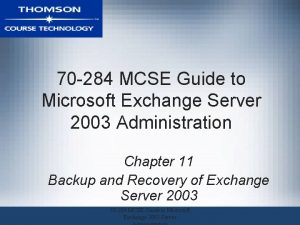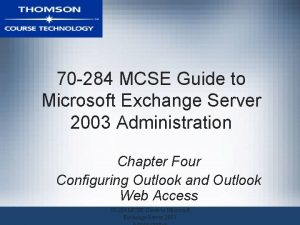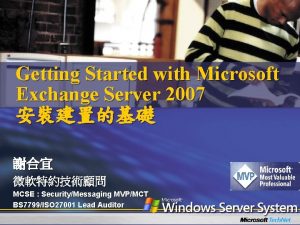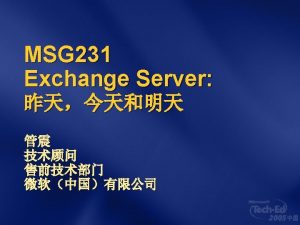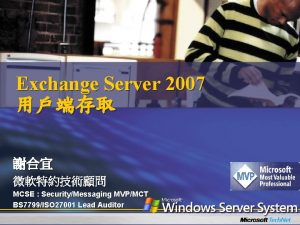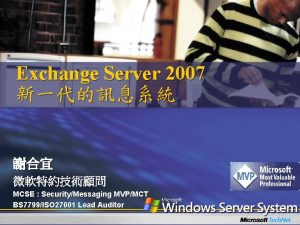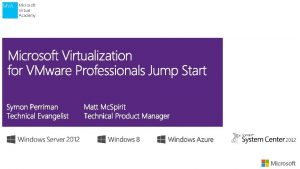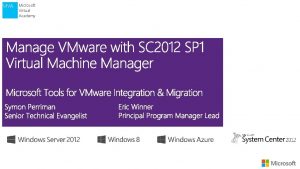70 284 MCSE Guide to Microsoft Exchange Server

































































- Slides: 65

70 -284 MCSE Guide to Microsoft Exchange Server 2003 Administration Chapter Two Installing and Configuring Exchange Server 2003 70 -284 MCSE Guide to Microsoft Exchange Server 2003 Administration

Objectives • Differentiate between editions of Exchange Server 2003 • Prepare a Windows Server 2003 and an Active Directory environment for the installation of Exchange Server 2003 • Install Exchange Server 2003 70 -284 MCSE Guide to Microsoft Exchange Server 2003 Administration 2

Objectives (continued) • Identify and access Exchange Server 2003 administration and management tools • Configure Exchange Server 2003 modes, global settings, and policies • Configure server properties for an Exchange Server 2003 system • Configure DNS to support Exchange Server 2003 70 -284 MCSE Guide to Microsoft Exchange Server 2003 Administration 3

Installing and Configuring Exchange Server 2003 • Two main tools are used to manage and configure related settings – Exchange System Manager • Used to manage everything from an organization-wide setting to message queues – Active Directory Users and Computers 70 -284 MCSE Guide to Microsoft Exchange Server 2003 Administration 4

Exchange Server 2003 Editions • Exchange Server 2003, Standard Edition • Exchange Server 2003, Enterprise Edition 70 -284 MCSE Guide to Microsoft Exchange Server 2003 Administration 5

Exchange Server 2003, Standard Edition • Targeted for small to medium-sized businesses • Limitations include: – Support for a maximum of one storage group – Support for a maximum of one mailbox store and one public folder store per storage group – A maximum per-database size of 16 GB – No clustering support – The X. 400 connector is not included 70 -284 MCSE Guide to Microsoft Exchange Server 2003 Administration 6

70 -284 MCSE Guide to Microsoft Exchange Server 2003 Administration 7

70 -284 MCSE Guide to Microsoft Exchange Server 2003 Administration 8

Exchange Server 2003, Enterprise Edition • Aimed at enterprise customers • Features include: – Support for up to four storage groups – Support for up to five databases – A maximum database size of 8 TB – Support for clustering of eight nodes – Built-in X. 400 connector 70 -284 MCSE Guide to Microsoft Exchange Server 2003 Administration 9

70 -284 MCSE Guide to Microsoft Exchange Server 2003 Administration 10

Preparing to Install Exchange Server 2003 • Steps completed prior to installing Exchange Server 2003 include: – Installing the Windows Server 2003 services required by Exchange – Running the Forest. Prep tool – Running the Domain. Prep tool 70 -284 MCSE Guide to Microsoft Exchange Server 2003 Administration 11

Installing Windows Server 2003 Services • Windows Server 2003 services that must be installed first: –. NET Framework – ASP. NET – Internet Information Services (IIS) – World Wide Web Publishing service – Simple Mail Transfer Protocol (SMTP) service – Network News Transfer Protocol (NNTP) service 70 -284 MCSE Guide to Microsoft Exchange Server 2003 Administration 12

Activity 2 -1: Installing Windows Server 2003 Services Required for Exchange Server 2003 • Time Required: 10– 15 minutes • Objective: Install services required prior to install of Exchange Server 2003 • Description: Install specific services required by Exchange Server 2003 70 -284 MCSE Guide to Microsoft Exchange Server 2003 Administration 13

70 -284 MCSE Guide to Microsoft Exchange Server 2003 Administration 14

70 -284 MCSE Guide to Microsoft Exchange Server 2003 Administration 15

Running Forest. Prep • Forest. Prep tool must be run to prepare the environment for Exchange Server 2003 • Must be run in the Active Directory domain where the domain controller holding the role of schema master resides 70 -284 MCSE Guide to Microsoft Exchange Server 2003 Administration 16

Running Forest. Prep (continued) • Main functions carried out by Forest. Prep include: – Extending the Active Directory schema to include required classes and attributes – Creating the Exchange organization container object in Active Directory – Designating a user or group account to have Administrator permissions 70 -284 MCSE Guide to Microsoft Exchange Server 2003 Administration 17

Activity 2 -2: Preparing an Active Directory Forest for Exchange Using Forest. Prep • Time Required: 20– 30 minutes • Objective: Run Forest. Prep to prepare your Active Directory forest for the installation of Exchange Server 2003 • Description: Create an Active Directory Forest. The forest first must be prepared by running the Forest. Prep tool. 70 -284 MCSE Guide to Microsoft Exchange Server 2003 Administration 18

70 -284 MCSE Guide to Microsoft Exchange Server 2003 Administration 19

Running Domain. Prep • Domain. Prep needs to be run in each of the following domains: – The Active Directory forest root domain – Any domains that will contain Exchange Server 2003 systems – Any domain that will contain Exchange Server 2003 mail-enabled objects 70 -284 MCSE Guide to Microsoft Exchange Server 2003 Administration 20

Running Domain. Prep (continued) – Any domains that include domain controllers configured as global catalog servers – Any domains that include user or group accounts that will manage the Exchange Server 2003 organization 70 -284 MCSE Guide to Microsoft Exchange Server 2003 Administration 21

Running Domain. Prep (continued) • The main functions carried out by Domain. Prep include: – Creating the Exchange Domain Servers global group and Exchange Enterprise Servers local group in Active Directory – Making the Exchange Domain Servers global group a member of both the Exchange Enterprise Servers and the Pre-Windows 2000 Compatible Access local groups 70 -284 MCSE Guide to Microsoft Exchange Server 2003 Administration 22

Running Domain. Prep (continued) – Creating the Exchange System Objects container – Configuring permissions for the Exchange Enterprise Servers group 70 -284 MCSE Guide to Microsoft Exchange Server 2003 Administration 23

Running Domain. Prep (continued) – Modifying the Admin. Sd. Holder template that sets permissions for the Administrators local group – Performing preinstallation checks prior to installing Exchange Server 2003 70 -284 MCSE Guide to Microsoft Exchange Server 2003 Administration 24

Activity 2 -3: Preparing an Active Directory Domain for Exchange Using Domain. Prep • Time Required: 5– 10 minutes • Objective: Run Domain. Prep to prepare your Active Directory domain for the installation of Exchange Server 2003 • Description: The Active Directory domain must be prepared by running the Domain. Prep prior to installing Exchange Server 2003 70 -284 MCSE Guide to Microsoft Exchange Server 2003 Administration 25

Installing Exchange Server 2003 • Install after: – Basic service have been installed – Forest. Prep has been run – Domain. Prep has been run 70 -284 MCSE Guide to Microsoft Exchange Server 2003 Administration 26

Activity 2 -4: Installing Exchange Server 2003, Enterprise Edition • Time Required: 40– 50 minutes • Objective: Install Exchange Server 2003 on your Windows Server 2003 system • Description: All services must be installed and Forest. Prep and Domain. Prep run prior to installing the Enterprise Edition 70 -284 MCSE Guide to Microsoft Exchange Server 2003 Administration 27

70 -284 MCSE Guide to Microsoft Exchange Server 2003 Administration 28

Unattended Installations of Exchange Server 2003 • Unattended installations can be used for the following tasks: – Installing Exchange Server 2003 on all but the first Exchange server in the organization – Installing the Exchange Server 2003 System Management tools – Running Domain. Prep in all but the first domain 70 -284 MCSE Guide to Microsoft Exchange Server 2003 Administration 29

Unattended Installations of Exchange Server 2003 (continued) • The administrator first needs to create an answer file • Copy the answer file to the server about to get the installation and issue the install command 70 -284 MCSE Guide to Microsoft Exchange Server 2003 Administration 30

Deploying Exchange Server 2003 in a Cluster • A cluster is a group of independent servers that work together to ensure high system availability • Each server is referred to as a node • Maximum number of nodes supported in an Exchange Server 2003 cluster is eight 70 -284 MCSE Guide to Microsoft Exchange Server 2003 Administration 31

Deploying Exchange Server 2003 in a Cluster (continued) 70 -284 MCSE Guide to Microsoft Exchange Server 2003 Administration 32

Exchange Server 2003 Administration Tools • The two primary tools used to manage an Exchange organization – Exchange System Manager – Active Directory Users and Computers 70 -284 MCSE Guide to Microsoft Exchange Server 2003 Administration 33

Exchange System Manager • Exchange System Manager is used to manage an Exchange Server environment and related system settings • Microsoft Management Console (MMC) can also be added to custom consoles that include other administrative tools 70 -284 MCSE Guide to Microsoft Exchange Server 2003 Administration 34

Exchange System Manager (continued) • Common administrative tasks – Configuration of global settings, such as message formats, message delivery options, and mobile service settings – Configuration of recipient settings, including templates, address lists, update services, and policies 70 -284 MCSE Guide to Microsoft Exchange Server 2003 Administration 35

Exchange System Manager (continued) – Configuration and management of administrative groups and routing groups – Configuration and management of server settings, including message queues, storage groups, and protocols – Configuration of connectors between Exchange and other messaging systems 70 -284 MCSE Guide to Microsoft Exchange Server 2003 Administration 36

Exchange System Manager (continued) – Delegation of Exchange administrative roles – Configuration of server and recipient policies 70 -284 MCSE Guide to Microsoft Exchange Server 2003 Administration 37

Activity 2 -5: Exploring Exchange System Manager • Time Required: 10 minutes • Objective: Access and explore the Exchange System Manager tool • Description: Exchange System Manager is used to manage an Exchange organization 70 -284 MCSE Guide to Microsoft Exchange Server 2003 Administration 38

Active Directory Users and Computers • Active Directory Users and Computers is used to manage user, group, and computer account objects 70 -284 MCSE Guide to Microsoft Exchange Server 2003 Administration 39

Active Directory Users and Computers (continued) • Administrative tasks performed with Active Directory Users and Computers include: – Configuring e-mail addresses for users and groups – Enabling or disabling user access to Exchange features – Configuring user delivery options, delivery restrictions, and storage limits – Configuring mailbox rights – Creating and managing distribution groups 70 -284 MCSE Guide to Microsoft Exchange Server 2003 Administration 40

Activity 2 -6: Exploring Exchangerelated Changes to Active Directory Users and Computers • Time Required: 10 minutes • Objective: Access and explore changes to Active Directory Users and Computers after Exchange Server 2003 has been installed • Description: Use Active Directory Users and Computers tool to open and explore Active Directory Users and Computers 70 -284 MCSE Guide to Microsoft Exchange Server 2003 Administration 41

Customized Consoles • Users can create customized MMCs that include the specific snap-ins that you work with on a regular basis 70 -284 MCSE Guide to Microsoft Exchange Server 2003 Administration 42

Activity 2 -7: Creating a Custom MMC • Time Required: 10 minutes • Objective: Create a custom MMC that includes both the Exchange System Manager and Active Directory Users and Computers tools • Description: Create custom MMCs as a way to consolidate administrative tools within a single environment 70 -284 MCSE Guide to Microsoft Exchange Server 2003 Administration 43

Picking a Server Management Location • Preferable to install the required server tools on a management workstation • Can be installed on a Windows XP Professional system running Service Pack 1 or higher 70 -284 MCSE Guide to Microsoft Exchange Server 2003 Administration 44

Managing Exchange Server 2003 • Management-related tasks include: – Switching an Exchange organization from mixed mode to native mode – Configuring Exchange global settings – Configuring Exchange server property settings – Working with system policies 70 -284 MCSE Guide to Microsoft Exchange Server 2003 Administration 45

Switching from Mixed Mode to Native Mode • Exchange organization runs in mixed mode by default • Run in native mode if your organization does not need to support interoperability with Exchange Server 5. 5 systems 70 -284 MCSE Guide to Microsoft Exchange Server 2003 Administration 46

Switching from Mixed Mode to Native Mode (continued) • The benefits of native mode include: – Creating query-based distribution groups – Bandwidth savings, because bridgehead servers will use 8 BITMIME data transfer rather than the 7 -bit exchanges used in Exchange Server 5. 5 environments – The ability for routing groups to contain servers for different administrative groups 70 -284 MCSE Guide to Microsoft Exchange Server 2003 Administration 47

Switching from Mixed Mode to Native Mode (continued) – The ability to move Exchange Server 2003 systems between routing groups – The ability to move mailboxes between administrative groups – SMTP is used as the default routing protocol 70 -284 MCSE Guide to Microsoft Exchange Server 2003 Administration 48

Activity 2 -8: Switching Exchange Server 2003 to Native Mode • Time Required: 10 minutes • Objective: Switch Exchange Server 2003 from mixed mode to native mode • Description: Exchange Server 2003 features are not available until an Exchange organization is promoted from mixed mode to native mode 70 -284 MCSE Guide to Microsoft Exchange Server 2003 Administration 49

Configuring Global Settings • The Global Settings node consists of three main configuration areas: – Internet Message Formats – Message Delivery – Mobile Services 70 -284 MCSE Guide to Microsoft Exchange Server 2003 Administration 50

Internet Message Formats • Control how e-mail messages are formatted when sent to or received from Internet clients • SMTP converts the message from Microsoft Rich Text Format (RTF) to Multipurpose Internet Mail Extensions (MIME) format 70 -284 MCSE Guide to Microsoft Exchange Server 2003 Administration 51

Internet Message Formats (continued) 70 -284 MCSE Guide to Microsoft Exchange Server 2003 Administration 52

Message Delivery • The Global Settings Message Delivery node allows you to configure message delivery options for your Exchange organization 70 -284 MCSE Guide to Microsoft Exchange Server 2003 Administration 53

Activity 2 -9: Configuring Exchange Global Settings • Time Required: 15 minutes • Objective: Configure global settings on an Exchange Server 2003 system • Description: Configurable Global Settings in Exchange System Manager include Internet Message Formats and Message Delivery settings 70 -284 MCSE Guide to Microsoft Exchange Server 2003 Administration 54

Configuring Server Property Settings • Used to control the functions of a particular Exchange Server 2003 system 70 -284 MCSE Guide to Microsoft Exchange Server 2003 Administration 55

Activity 2 -10: Exploring and Configuring Server Settings • Time Required: 15 minutes • Objective: Explore and configure Exchange Server 2003 server property settings • Description: A large number of configurable settings are available in the Properties pages of an Exchange server 70 -284 MCSE Guide to Microsoft Exchange Server 2003 Administration 56

Working with System Policies • System Policies are a collection of settings that can be applied to these objects once, rather than individually • Policies are applied to an object (such as a server) • One system policy can be applied to an object at any given point in time 70 -284 MCSE Guide to Microsoft Exchange Server 2003 Administration 57

Working with System Policies (continued) • Exchange Server 2003 supports three kinds of system policies: – Mailbox store policies – Public folder store policies – Server policies 70 -284 MCSE Guide to Microsoft Exchange Server 2003 Administration 58

Activity 2 -11: Creating and Applying Server Policies • Time Required: 15 minutes • Objective: Create and apply a server policy to an Exchange Server 2003 system • Description: Server system policies help administrators to apply and enforce configuration settings on multiple servers simultaneously, without the need to configure each server individually 70 -284 MCSE Guide to Microsoft Exchange Server 2003 Administration 59

Configuring DNS To Support Exchange Server 2003 Internet EMail • Domain Name Service (DNS) provides name resolution services on a Transmission Control Protocol/Internet Protocol (TCP/IP) network • Mail servers are listed in DNS using a special type of resource record known as a Mail Exchanger (MX) 70 -284 MCSE Guide to Microsoft Exchange Server 2003 Administration 60

Configuring DNS to Support Exchange Server 2003 Internet E-Mail (continued) 70 -284 MCSE Guide to Microsoft Exchange Server 2003 Administration 61

Activity 2 -12: Configuring DNS to Support Exchange Server 2003 Internet E-mail • Time Required: 5 minutes • Objective: Configure DNS with an MX record to support Exchange Server 2003 as an Internet-based SMTP server • Description: DNS MX records are used to designate mail servers within the DNS infrastructure on the Internet 70 -284 MCSE Guide to Microsoft Exchange Server 2003 Administration 62

Summary • Two editions of Exchange Server 2003 exist – Exchange Server 2003, Standard Edition – Exchange Server 2003, Enterprise Edition • The first server in an Active Directory environment must run Forest. Prep and Domain. Prep 70 -284 MCSE Guide to Microsoft Exchange Server 2003 Administration 63

Summary (continued) • Tools used to manage an Exchange Server 2003 organization are Exchange System Manager and Active Directory Users and Computers • Installed Exchange organizations run in mixed mode to support environments that include Exchange 5. 5 servers 70 -284 MCSE Guide to Microsoft Exchange Server 2003 Administration 64

Summary (continued) • Exchange Server 2003 supports the use of system policies to enforce consistent settings • DNS MX records are used by sending mail servers to find a recipient’s mail server 70 -284 MCSE Guide to Microsoft Exchange Server 2003 Administration 65
 Mcse exchange server
Mcse exchange server Microsoft mcsa private cloud
Microsoft mcsa private cloud Microsoft forefront protection 2010 for exchange server
Microsoft forefront protection 2010 for exchange server Microsoft forefront security for exchange server
Microsoft forefront security for exchange server Round 284 to the nearest ten.
Round 284 to the nearest ten. 2812840027
2812840027 305 in word form
305 in word form 284 ad
284 ad 284
284 Cs 284
Cs 284 When diocletian took power in a.d. 284, he
When diocletian took power in a.d. 284, he 284
284 284-pwrm
284-pwrm Mcse wikipedia
Mcse wikipedia Mcse windows 7
Mcse windows 7 Mcp mcse
Mcp mcse Real exchange rate formula
Real exchange rate formula Voluntary exchange
Voluntary exchange Gas exchange key events in gas exchange
Gas exchange key events in gas exchange Exchange 2010 management tools
Exchange 2010 management tools 311 sever
311 sever Microsoft exchange best practices
Microsoft exchange best practices Exchange virtual server
Exchange virtual server Exchange fax server
Exchange fax server Cb exchange server sync
Cb exchange server sync Virtual exchange stock
Virtual exchange stock Microsoft exchange 2010 email archiving
Microsoft exchange 2010 email archiving Microsoft exchange mitigation
Microsoft exchange mitigation Microsoft exchange
Microsoft exchange Microsoft windows small business server 2011 essentials
Microsoft windows small business server 2011 essentials Microsoft windows small business server 2011 essentials
Microsoft windows small business server 2011 essentials Microsoft sql server 2005 analysis services
Microsoft sql server 2005 analysis services Microsoft project server resource management
Microsoft project server resource management Sql server machine learning services
Sql server machine learning services Microsoft sql server introduction
Microsoft sql server introduction Project portfolio server
Project portfolio server Microsoft storage server
Microsoft storage server Loginsscan
Loginsscan Polybase query service for external data
Polybase query service for external data Sql server 2005 express management studio
Sql server 2005 express management studio Parallel data warehouse sql server 2012
Parallel data warehouse sql server 2012 What is microsoft epm
What is microsoft epm Microsoft windows storage server 2003
Microsoft windows storage server 2003 Microsoft server
Microsoft server Microsoft sql server migration assistant for oracle
Microsoft sql server migration assistant for oracle Project server architecture
Project server architecture Sql server kerberos configuration manager
Sql server kerberos configuration manager Raspberry pi mssql server
Raspberry pi mssql server Microsoft identity integration server
Microsoft identity integration server Mts explorer
Mts explorer Project server 2003
Project server 2003 Ms sql security best practices
Ms sql security best practices Sql server compact edition
Sql server compact edition Tpcall
Tpcall Microsoft host integration server
Microsoft host integration server Microsoft planner quick start guide
Microsoft planner quick start guide Microsoft dynamics nav 2009 installation guide
Microsoft dynamics nav 2009 installation guide Teams quick start guide
Teams quick start guide Ms teams quick start guide
Ms teams quick start guide Microsoft official academic course microsoft word 2016
Microsoft official academic course microsoft word 2016 Microsoft official academic course microsoft excel 2016
Microsoft official academic course microsoft excel 2016 Microsoft startwarren theverge
Microsoft startwarren theverge Microsoft excel merupakan aplikasi …. *
Microsoft excel merupakan aplikasi …. * Microsoft official academic course microsoft word 2016
Microsoft official academic course microsoft word 2016 Where did garlic come from in the columbian exchange
Where did garlic come from in the columbian exchange Work, exchange and technology
Work, exchange and technology









